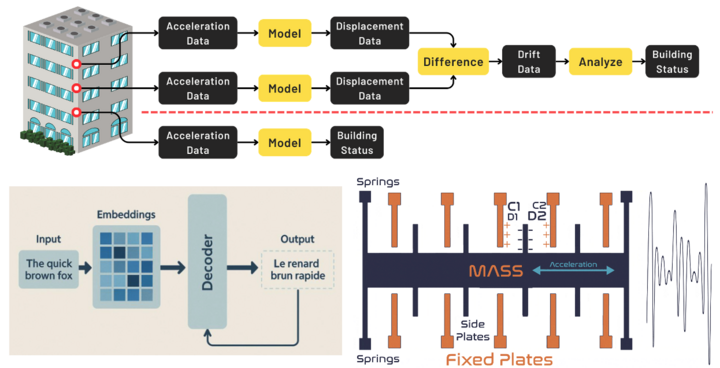Integrated Research on Infrastructure Resilience
Integrating digital twins, sensing, and decision support for multi-hazard resilience
The SiRIUS Lab investigates how interconnected infrastructure and urban systems perform, fail, and recover under compounding natural hazards and climate stressors. Our research integrates structural sensing, data fusion, and computational modeling to develop digital twins that capture system behavior across multiple scales.
We focus on earthquakes, extreme wind, flooding, fire, and climate-driven hazards, with applications ranging from instrumented structures to community-scale systems. By embedding these models within decision-support and resilience platforms, we aim to translate data and analysis into actionable insights for planning, design, and post-disaster recovery.
At the core of our work is the concept of resilience intelligence: a systems-based approach that treats infrastructure resilience as an evolving property of cyber-physical-social systems. Rather than analyzing hazards or infrastructure components in isolation, we integrate physical models, intelligent sensing, data–model fusion, and socio-economic decision frameworks to understand how disruptions propagate and how communities can adapt under climate-driven uncertainty.
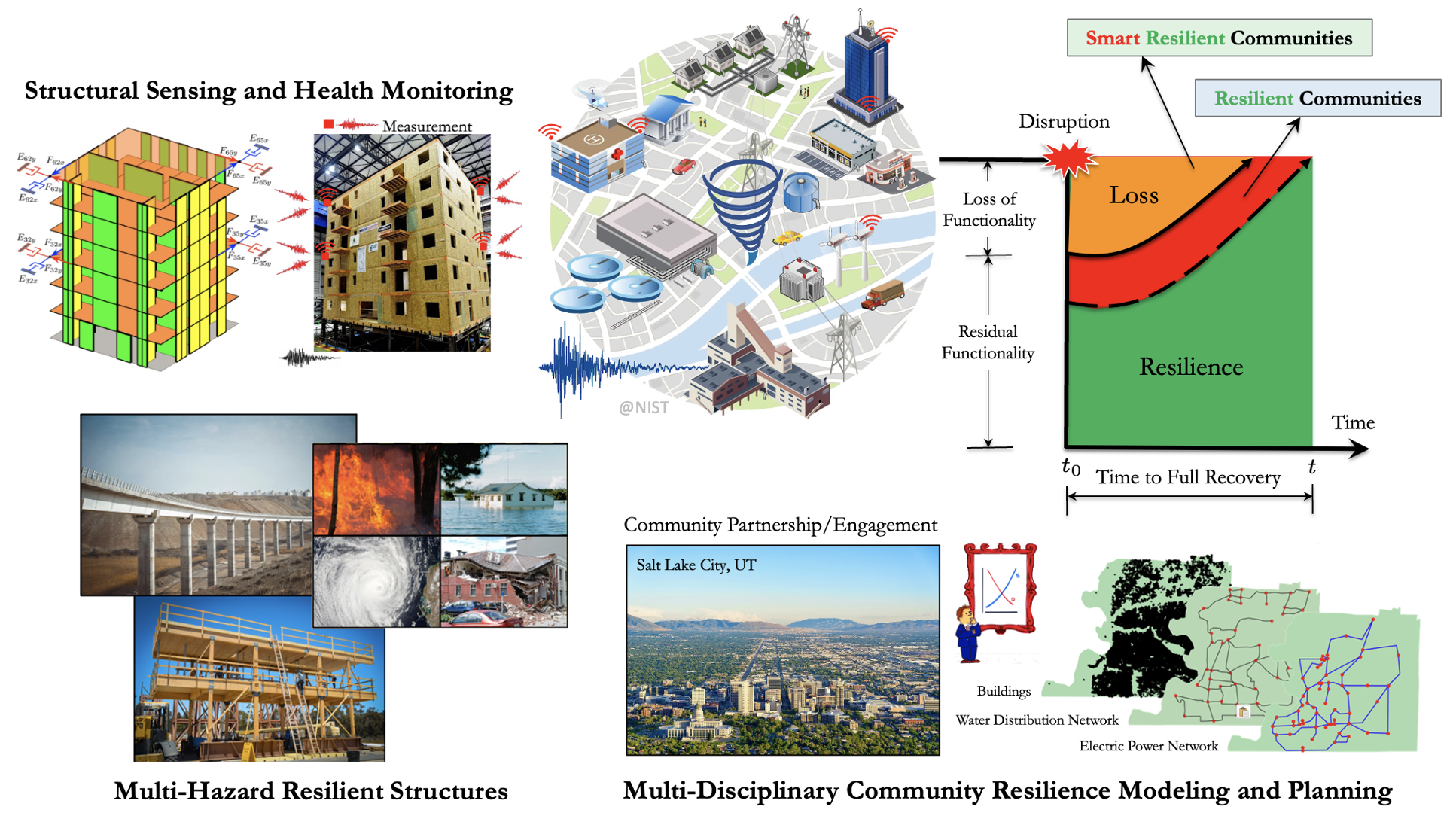
Research Themes and Projects
Digital Twins & Monitoring
We develop physics-based and data-driven digital twins of buildings and infrastructure systems using structural sensing, data fusion, and health monitoring. Our research focuses on extracting system-level information from sparse and heterogeneous data to characterize damage, functionality, and performance before and after extreme events.
These digital twins support rapid diagnostics, scenario evaluation, and uncertainty-aware decision-making, particularly in post-disaster environments where data may be incomplete or degraded. Applications include instrumented buildings, transportation infrastructure, and critical facilities.
Compounding Hazards
Infrastructure systems are increasingly exposed to interacting and sequential hazards. Our research addresses compounding hazards—including earthquakes, extreme wind, flooding, fire, and climate-driven stressors—by modeling how damage and disruptions cascade across infrastructure networks and communities.
We quantify risk, reliability, and recovery under multi-hazard scenarios while accounting for interdependencies among structural systems, lifelines, and social functions. This work supports hazard-informed planning, mitigation prioritization, and resilience-based design.
Community Resilience
We translate complex models into actionable insights for engineers, planners, and policymakers. Using community resilience modeling, recovery simulation, and scenario analysis, we support decisions related to mitigation investment, retrofit prioritization, and post-disaster recovery planning.
Our work is applied in real communities through partnerships with federal agencies, state and local governments, and resilience platforms, ensuring that analytical tools directly inform practice rather than remain purely academic.
AI, Data Science & Uncertainty
We develop artificial intelligence and data science methods tailored to natural hazards and infrastructure resilience problems. Our work emphasizes physics-informed and interpretable approaches that integrate machine learning with probabilistic modeling and uncertainty quantification.
These methods support rapid damage assessment, performance prediction, and risk-informed decision-making while maintaining transparency and reliability for engineering and policy applications.
Structural Dynamics & Performance-Based Engineering
Our research advances structural dynamics and performance-based engineering methods for assessing and designing resilient structures. We investigate system identification, Bayesian filtering, and dynamic response reconstruction to evaluate damage, functionality, and recovery.
This work provides the mechanical foundation for digital twins, post-event assessment, and resilience-based design of buildings and infrastructure systems.
Community Resilience Decision Support and Mitigation Planning
National Institute of Standards and Technology (NIST)
This project advances community-scale decision-support methods to define resilience goals, diagnose vulnerabilities, and prioritize mitigation strategies using integrated engineering, social, and economic models.

Transforming Tribal Community Resilience to Extreme Wind
National Science Foundation (NSF)
This NSF-funded project develops a multidimensional framework that integrates engineering, social, and economic models to support extreme-wind resilience planning for tribal communities, with a strong emphasis on equity-centered decision support.

Integrated Bridge, Transportation Network, and Community Resilience
Nebraska Department of Transportation (NDOT)
This NDOT-funded research integrates bridge performance, transportation network disruption, and community impacts to support resilience-informed planning and infrastructure investment.
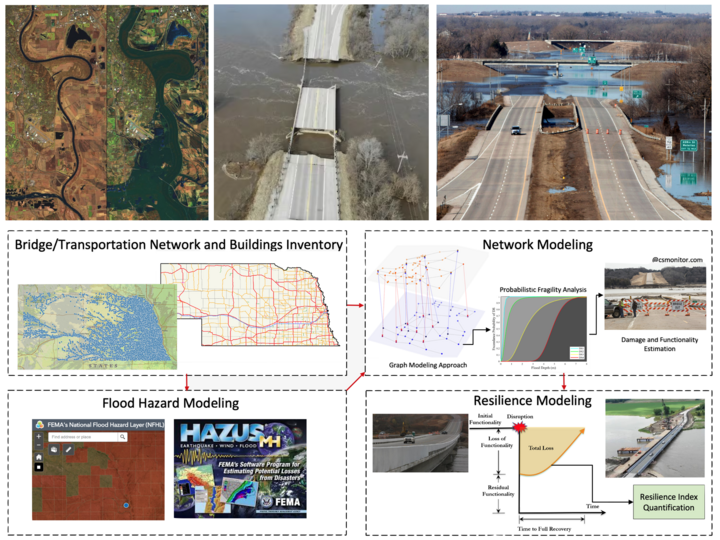
Research Projects by Funding Agency
National Science Foundation (NSF)
CIVIC-PG Track A: A Multidimensional Approach to Transform Tribal Community Resilience Against Extreme Wind Hazards (2024–2025)
Development of an equity-centered, multidimensional framework integrating engineering, social, and economic models to support extreme-wind resilience planning for tribal communities.
Performance-Based Post-Earthquake Decision-Making for Instrumented Buildings (2015–2019)
Development of a probabilistic framework integrating structural health monitoring and performance-based earthquake engineering for post-earthquake assessment and decision support, demonstrated using the Van Nuys Hotel testbed.
NSF EPSCoR Research Fellows: Multi-Sensor Smart Environments for Individuals with Functional Limitations (2025–2027)
Exploration of multi-sensor and AI-enabled environments to support resilience, safety, and functionality for vulnerable populations.
National Institute of Standards and Technology (NIST)
Community-Level Functional Recovery and Decision Support for Multi-Hazard Resilience (PREP) (2020-2023)
Development of a multi-disciplinary decision-support methodology under the NIST Planning for Economic Recovery and Prosperity (PREP) program. The project integrates engineering, social, and economic models within the IN-CORE platform to support resilience goal setting, vulnerability diagnosis, mitigation prioritization, and recovery planning. Implementation included real-world application with Los Angles County, CA.
Multi-Disciplinary Decision Support Methodology for Developing Mitigation Policies and Community Resilience Planning (2020–2025)
Development of an integrated engineering–social–economic decision-support framework using the IN-CORE platform, implemented with Salt Lake County, Utah.
Effects of Data Availability on Physical, Social, and Economic Resilience Metrics for Informed Decision-Making (2019–2021)
Quantification of how data availability and uncertainty affect resilience metrics across engineering, economic, and social dimensions, demonstrated using the Memphis Metropolitan Statistical Area (MMSA).
Nebraska Department of Transportation (NDOT)
Integrated Bridge, Transportation Network, and Community Resilience Framework for Nebraska (2023–2025)
A systems-level framework linking bridge damage, transportation network disruption, and community impacts to support resilience-informed planning and infrastructure investment.
Mid-America Transportation Center (MATC)
Equitable Resilience-Informed Strategies for Flood Risk Mitigation in Nebraska’s Transportation Infrastructure (2024–2025)
Assessment of flood hazards and climate stressors affecting transportation systems, supporting resilience-based mitigation and adaptation planning.
National Aeronautics and Space Administration (NASA EPSCoR)
Research Infrastructure Development for Advanced Sensing and Smart Environments (2024–2026)
Development of sensing and research infrastructure to support advanced monitoring, data integration, and smart infrastructure applications.
U.S. Department of Housing and Urban Development (HUD)
Cooperative Research to Enable Mass Timber Multi-Family Housing Technologies (2018–2021)
Development and seismic assessment of novel mass-timber structural systems, contributing directly to performance-based design standards and code provisions.
University of Nebraska–Lincoln (UNL) – Grand Challenges
Climate Resilient Heartland: Leveraging AI for Equitable Risk Reduction and Adaptation Across Rural and Urban Systems (2024–2025)
Development of AI-enabled tools to support climate adaptation and equitable risk reduction across interconnected rural and urban infrastructure systems.
Smart and Connected Long-Term Care Ecosystem with Robotic Caregiver (2024–2025)
Integration of sensing, AI, and cyber-physical systems to enhance safety, resilience, and decision support in long-term care environments.
UNL Durham School Seed Grants
Building Resilient Communities in the Face of Climate Change: Investigating AI Opportunities for Decision-Making and Code Adoption (2023–2025)
Investigation of AI-enabled methods to support climate-informed planning, policy development, and code adoption.
Low-Cost Bio-Inspired MEMS for Post-Earthquake Assessment of Buildings Through Neuromorphic Computing and Model–Data Fusion (2023–2025)
Development of low-cost sensing and neuromorphic computing approaches for rapid post-earthquake building assessment using sparse measurements.
Industry-Funded Research
Aon – Impact Forecasting
Catastrophe Loss Modeling and Community-Scale Risk Assessment for Natural Hazards (2019–2021)
Development of catastrophe modeling and risk analytics frameworks to assess hazard impacts, losses, and recovery at building, portfolio, and community scales, supporting insurance, risk management, and resilience planning.
Structural, Infrastructure and Community Systems Testbeds
We develop and apply community-scale testbeds to evaluate multi-hazard risk, infrastructure interdependencies, and recovery dynamics. These testbeds integrate physical infrastructure, social systems, and data-driven models to support resilience planning and decision-making.
Seismic SHM
NEESWood Instrumented Building
Full-scale instrumented building testbed
This testbed uses a full-scale instrumented wood building from the NEESWood project to study seismic response, damage detection, and performance assessment. Dense sensing and data-driven modeling support the development and validation of digital twins and structural health monitoring methods for earthquake engineering applications.
Multi-Hazard Risk
Memphis–Shelby County, Tennessee
New Madrid seismic zone
This testbed focuses on seismic risk and recovery in the New Madrid seismic zone, integrating building performance, lifeline systems, and community impacts to inform resilience planning and emergency preparedness.
Explore the IN-CORE seismic resilience analysis notebookEarthquake Resilience
Salt Lake City, Utah
Unreinforced masonry buildings and community recovery
This testbed evaluates seismic risk and recovery for unreinforced masonry buildings and interdependent infrastructure systems. Results have supported data-informed retrofit prioritization and community resilience planning through partnerships with local stakeholders.
Watch the Salt Lake City Resilience TestimonialExtreme Wind
Tornado-Affected Communities
Community-scale wind hazard resilience
We develop testbeds for communities affected by extreme wind and tornado hazards to assess building vulnerability, infrastructure disruption, and recovery processes, with emphasis on risk communication and decision support.
Flooding & Climate Impacts
Nebraska Flood Resilience Testbed
Transportation and community infrastructure systems
This testbed focuses on flood impacts and recovery of transportation and community infrastructure systems in Nebraska. The work integrates infrastructure performance, network disruption, and recovery modeling to support flood resilience planning, adaptation strategies, and hazard-informed decision-making at the local and regional scales.
Urban Systems
Los Angeles County, California
Infrastructure interdependencies and recovery modeling
We developed a community-scale testbed to analyze infrastructure performance, economic impacts, and recovery trajectories under seismic hazards. The testbed supports evaluation of mitigation strategies and policy-relevant resilience metrics.
Research Project Highlights
Multi-Disciplinary Decision Support for Community Resilience (NIST)
This project develops a multi-disciplinary decision-support methodology to assist communities in defining, evaluating, and achieving resilience goals under earthquake hazards. The framework integrates engineering, social, and economic models within the IN-CORE platform to quantify damage, functionality, recovery, and socio-economic impacts.
In partnership with the NIST Center for Risk-Based Community Resilience Planning, the methodology has been implemented for community resilience planning in Salt Lake County, Utah. Decision-makers define target resilience objectives, which are used to diagnose vulnerable building archetypes, prioritize retrofit strategies, and estimate the costs required to meet community-defined resilience goals.
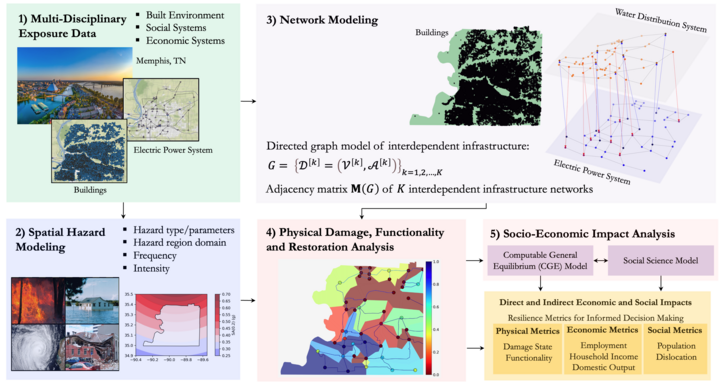
Performance-Based Post-Earthquake Decision-Making for Instrumented Buildings (NSF)
This NSF-funded project developed a probabilistic framework for post-earthquake assessment of instrumented buildings that is consistent with performance-based design principles. The framework integrates seismic structural health monitoring with performance-based earthquake engineering through measurement, uncertainty modeling, response reconstruction, damage estimation, and decision analysis.
The methodology is demonstrated using data from the Van Nuys Hotel testbed, a seven-story reinforced concrete building instrumented by the California Strong Motion Instrumentation Program. The outcomes support risk-informed decisions by building owners, emergency managers, and public agencies.

Seismic Functionality and Restoration of Interdependent Infrastructure Systems (NIST)
This project investigates seismic functionality and restoration of interdependent building, water, and power systems at the community scale. The research develops a systematic approach to quantify physical damage, service disruption, and recovery trajectories using integrated engineering and socio-economic models.
The methodology is demonstrated for the Memphis–Shelby County region using the IN-CORE platform, providing a foundation for interactive Jupyter-based analysis of restoration curves and interdependent system recovery. The results support resilience-informed planning for critical infrastructure systems.
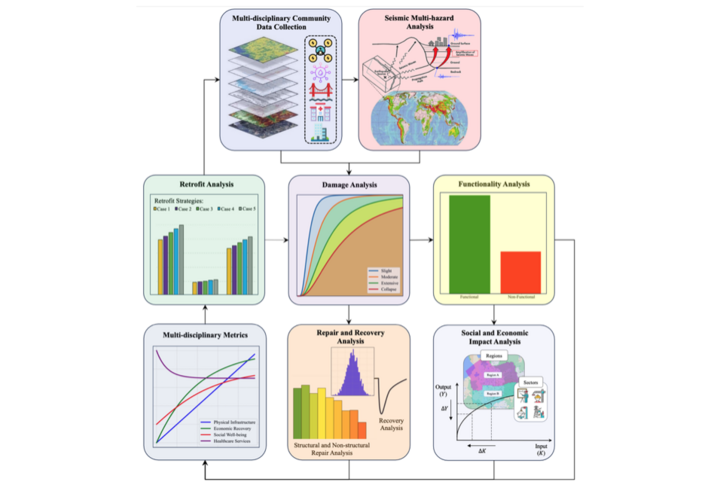
Intelligent Sensing and Bio-Inspired Technologies for Rapid Post-Disaster Assessment
This project explores low-cost, bio-inspired sensing technologies and neuromorphic computing approaches for rapid post-earthquake assessment of buildings. By combining novel sensing hardware with model–data fusion and probabilistic inference, the research aims to enable scalable and timely damage diagnostics following extreme events.
The work supports future digital-twin-enabled monitoring and decision-making under data-limited conditions.
